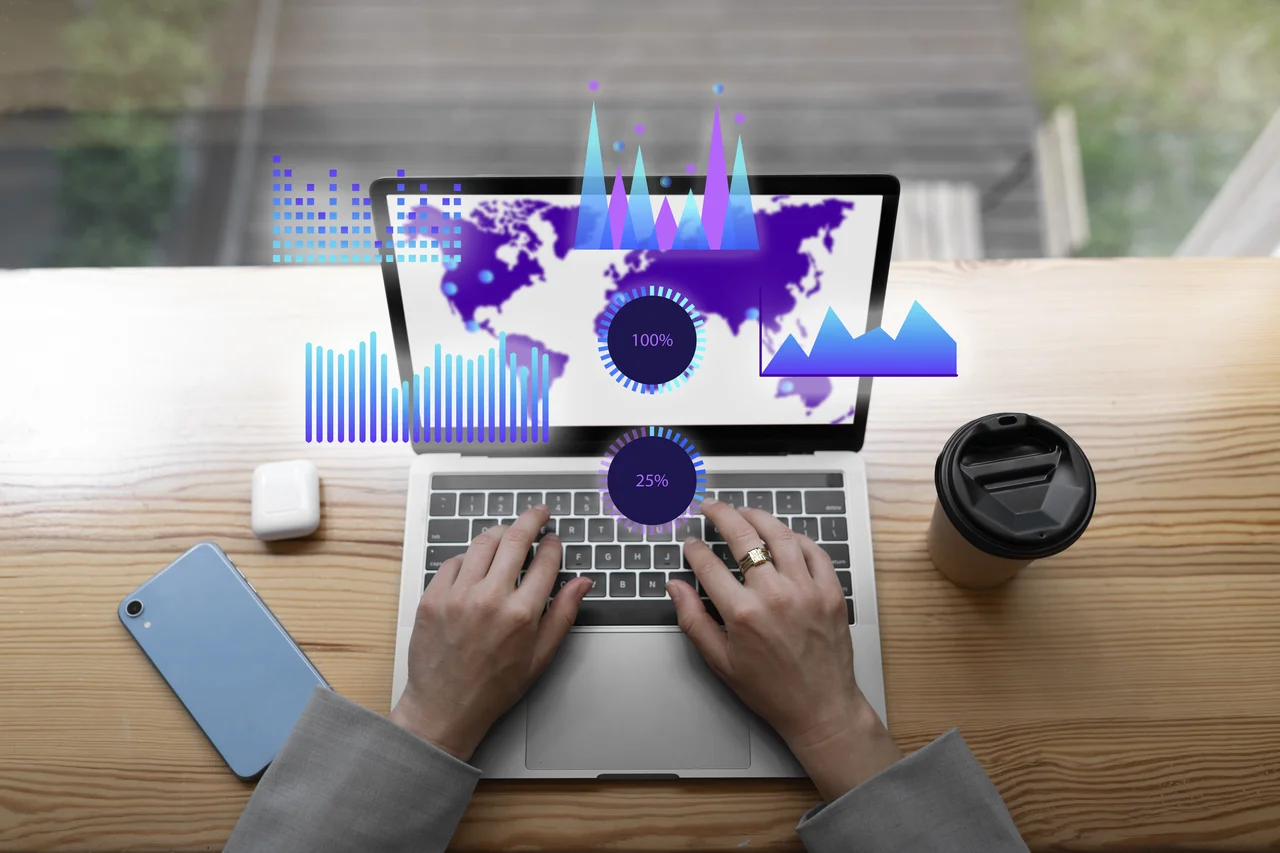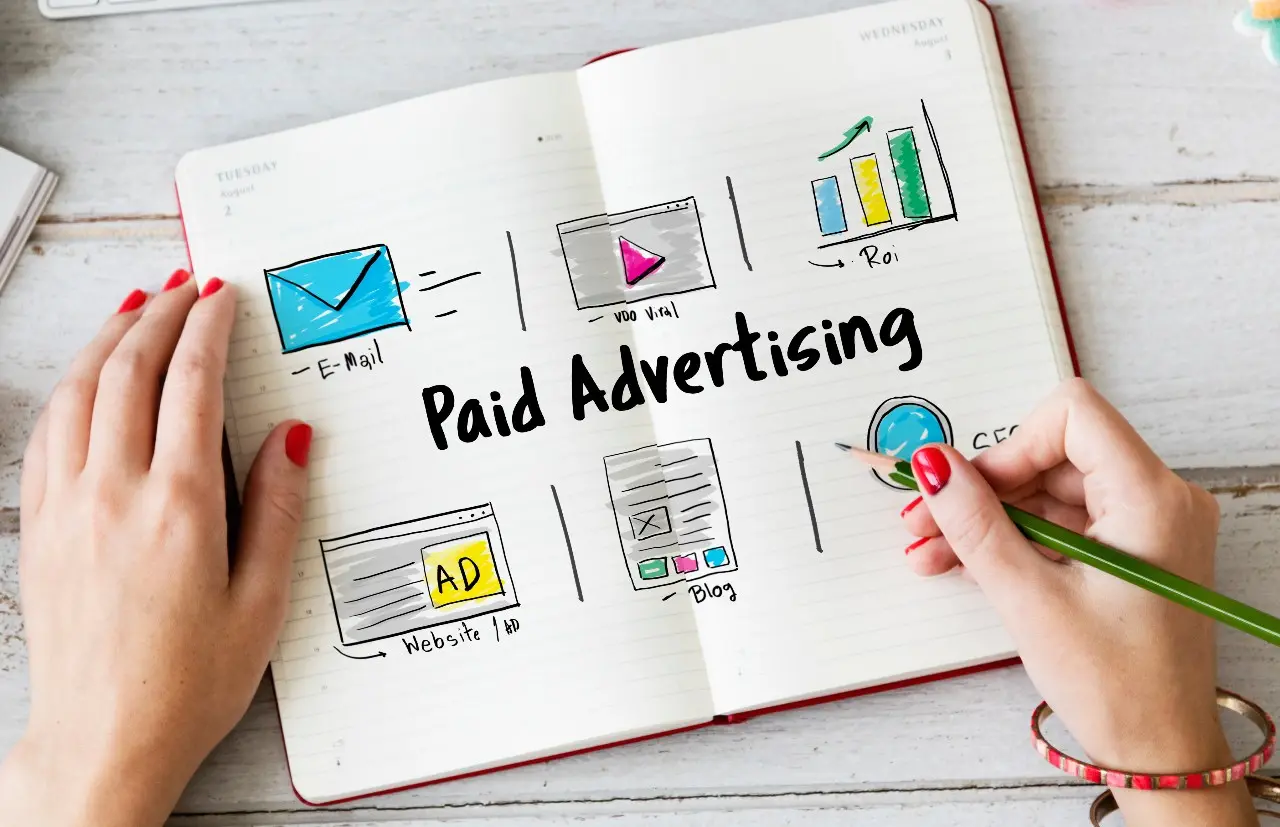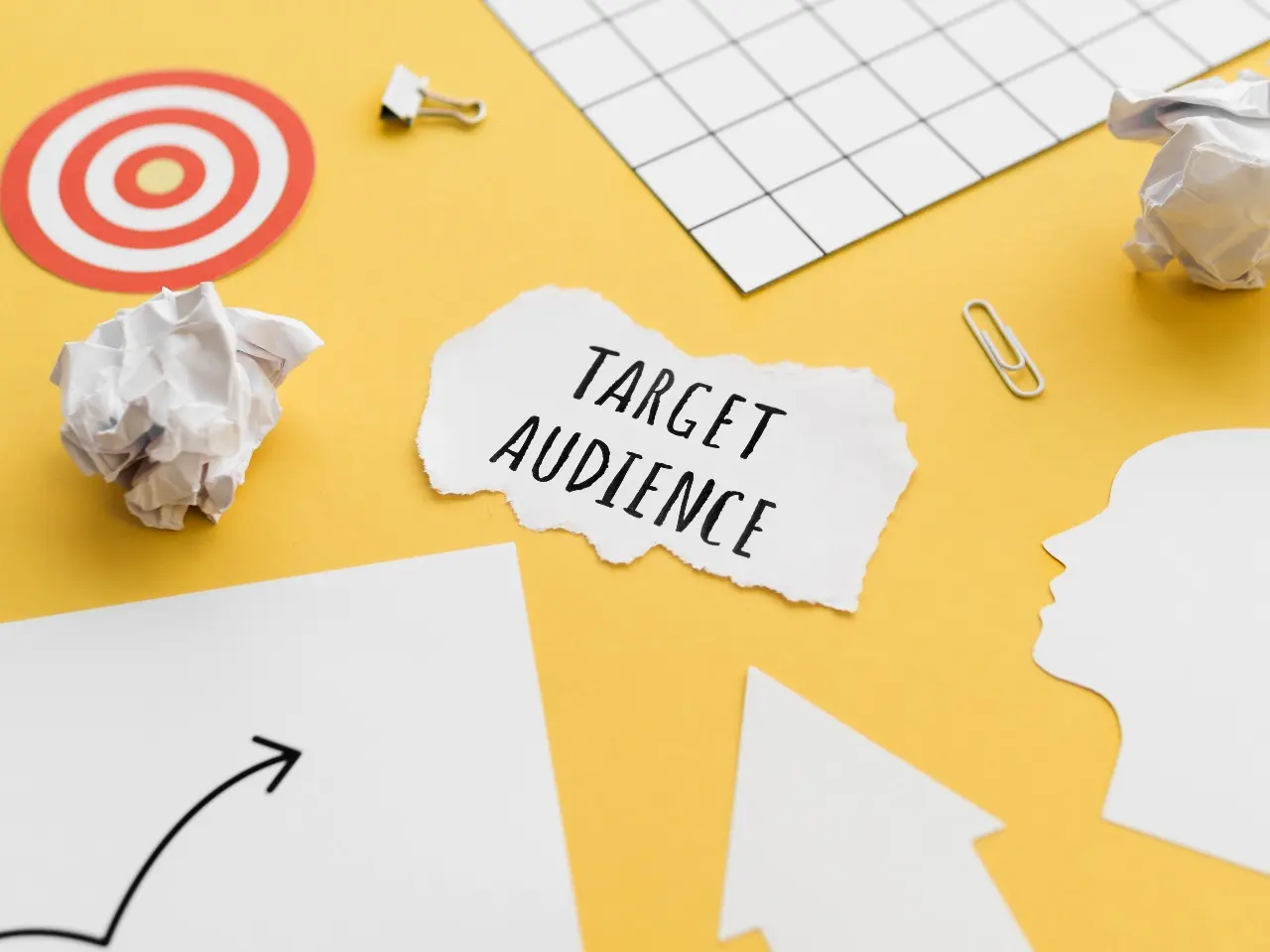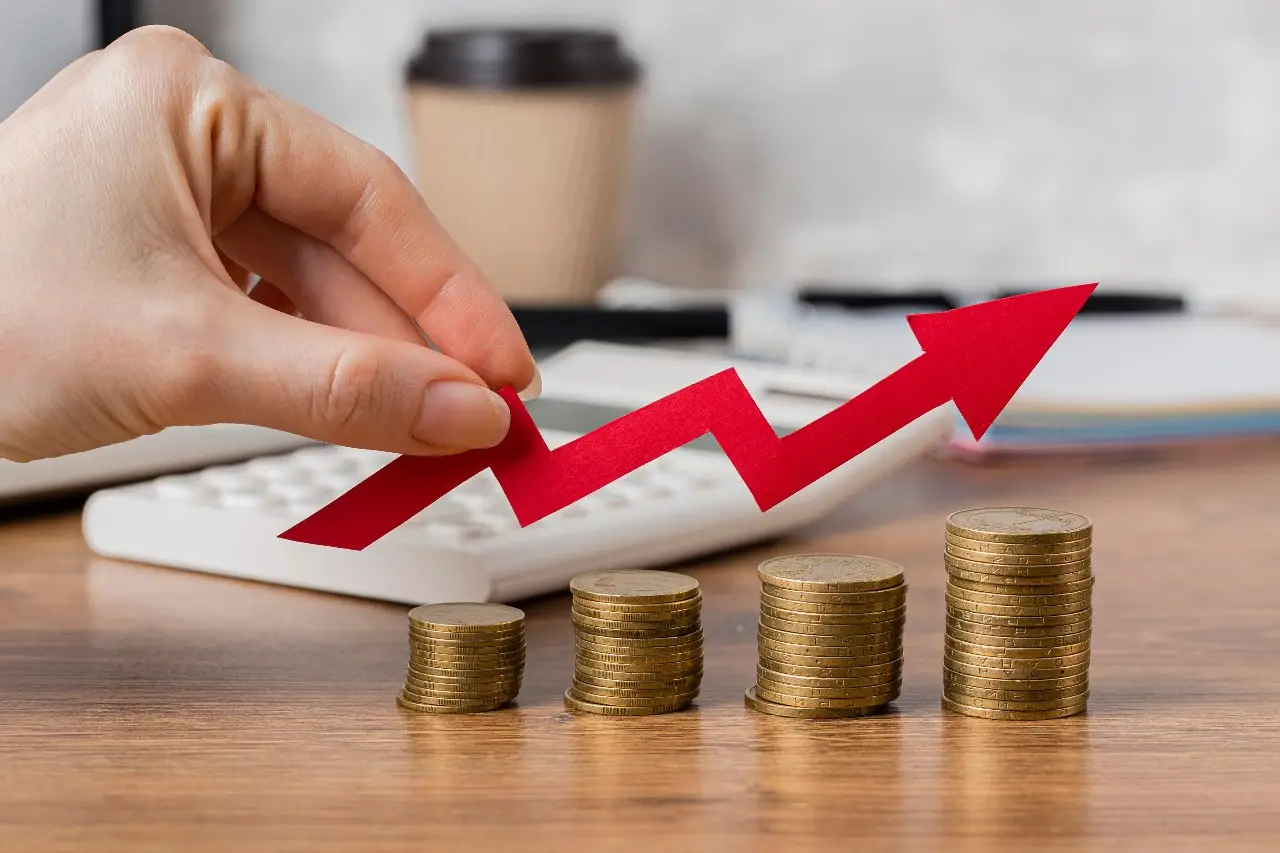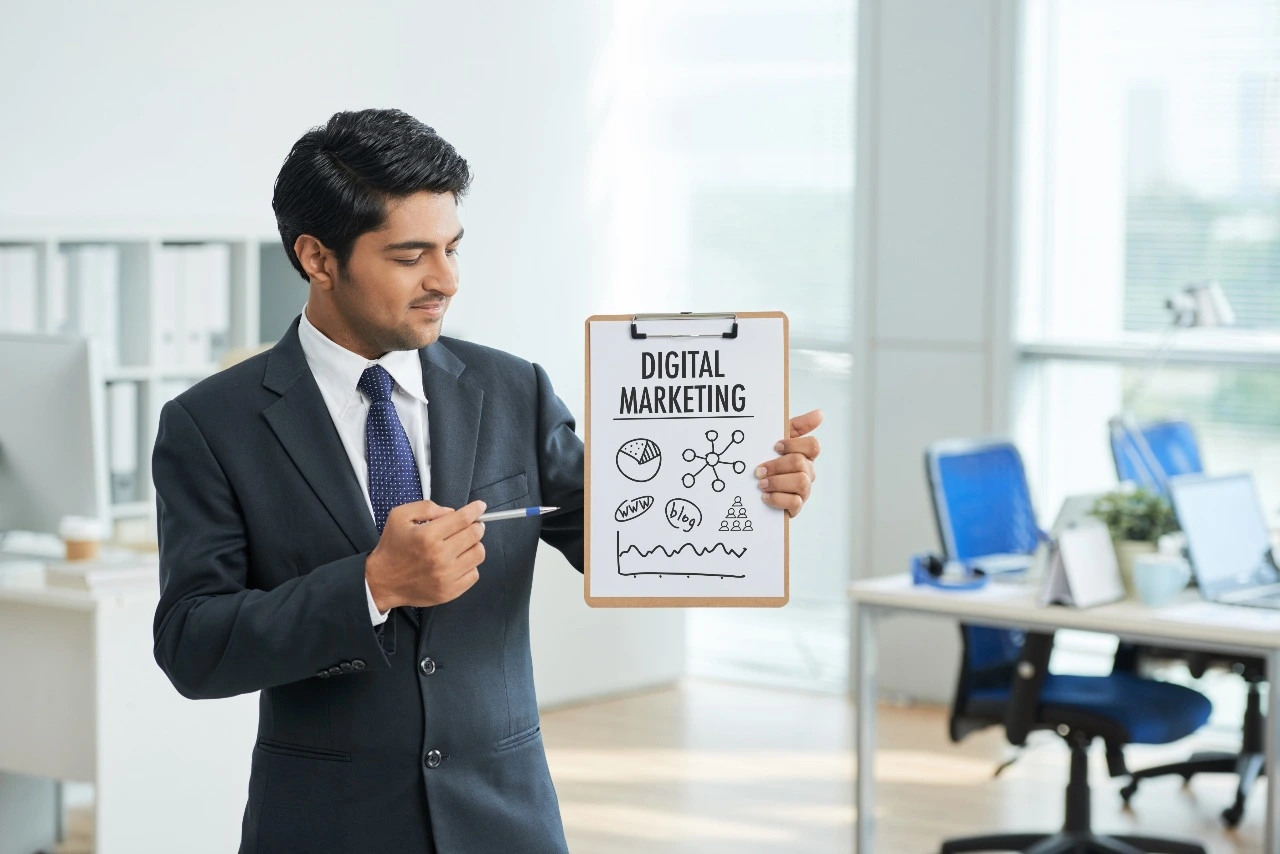Listen to article
In today’s marketing landscape, businesses often find themselves at a crossroads: should they invest in paid media or organic strategies? With so many options, it’s crucial to understand where your budget is best allocated and why.
Paid media offers immediate visibility and precise targeting, while organic strategies focus on long-term, sustainable growth. But which approach delivers the most bang for your buck?
This article dives deep into the world of paid media versus organic, providing a detailed analysis of budget allocation, ROI, and channel effectiveness. By exploring key statistics and trends, we’ll help you make informed decisions about your marketing investments and discover the optimal balance that drives success.
Paid Media for Brand Visibility
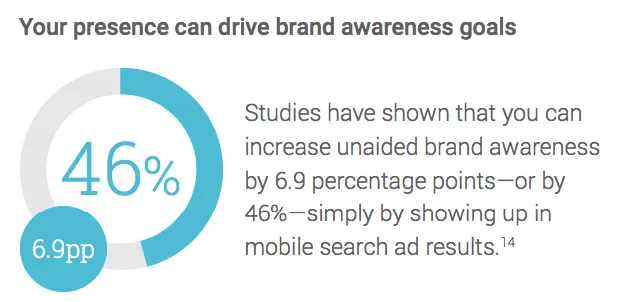
Source: LYFE marketing
In a crowded digital marketplace, standing out requires strategic investment in visibility. Paid media campaigns, especially PPC and display ads, are not just budget expenditures—they’re opportunities to dominate search results, re-engage audiences, and elevate brand recall. Unlike organic strategies that take time to build traction, paid media delivers measurable results more immediately, making it a critical component of a balanced marketing approach.
- PPC ads can increase brand awareness by up to 46%. Source
- Consumers exposed to display ads are 155% more likely to search for brand-specific terms. Source
- Digital advertising can enhance brand awareness by as much as 80%. Source
Key Takeaway
The statistics speak volumes—paid media isn’t just about ads; it’s about influence. By positioning your brand front and center in search results and across relevant platforms, you’re not only capturing attention but actively shaping consumer behavior. The key to success lies in targeting the right audience, crafting compelling ad content, and consistently refining campaigns based on data-driven insights.
Pro Tip:
Combine paid media with retargeting strategies. By reconnecting with users who’ve previously interacted with your brand, you can reinforce recall and maximize ROI from your advertising efforts. Platforms like Google Ads and Meta Ads Manager allow for precise segmentation to make retargeting campaigns even more impactful.
Why Paid Media Delivers Exceptional ROI
When it comes to driving measurable results in digital marketing, paid media stands out as a powerhouse. With its advanced targeting capabilities and ability to deliver quick, scalable results, businesses are increasingly leveraging paid campaigns to complement their organic efforts. But what makes paid media so effective isn’t just the “speed” of traffic—it’s the precision with which you can reach your ideal audience and convert them into loyal customers.
- Digital ad campaigns using location-specific targeting are 20 times more successful than traditional banner ads that lack location-based accuracy. Source
- Visitors who land on a website via paid ads are twice as likely to make a purchase compared to those arriving through organic search. Source
- 65% of small-to-midsize businesses (SMBs) actively invest in PPC campaigns, highlighting its widespread adoption. Source
- Pay-per-click (PPC) visitors are 50% more likely to make a purchase compared to those arriving through organic traffic. Source
Key Takeaway
Paid media thrives where organic strategies often fall short—precision targeting and maximising digital marketing ROI. Whether it’s location-specific campaigns or behavior-based targeting, the flexibility of paid media allows you to zero in on high-intent customers who are more likely to convert. The data further underscores how PPC campaigns are disproportionately effective in driving direct purchases and outperforming organic in certain metrics. However, to sustain success, experimentation is key: continually test new ad channels, refine messaging based on performance insights, and monitor changes in audience behavior.
Pro Tip:
To supercharge your PPC results, align ad copy and landing pages with the exact intent of your target audience. Utilize A/B testing to identify high-converting content, and consider layering retargeting strategies to re-engage users who didn’t convert on their first visit. Platforms like Google Ads and Meta Ads Manager offer robust tools to track and adjust campaign performance for maximum ROI.
Decoding ROI: The Impact of Paid and Organic Strategies
Allocating your marketing budget effectively begins with understanding the ROI potential of each channel. Paid media offers speed and scalability, while organic strategies like SEO and email marketing provide sustainability and compounding returns over time. The challenge isn’t choosing one over the other—it’s finding the right balance to drive both immediate and long-term business growth.
- Email marketing boasts one of the highest ROIs in digital marketing, rivaled by SEO, mobile marketing, and content marketing. Source
- Google Ads generates $8 for every $1.60 invested, showcasing the immediate potential of PPC. Source
- E-commerce brands achieve a staggering 317% ROI from SEO, typically breaking even within 16 months. Source
- Real estate companies experience unparalleled SEO success, with a 1,389% ROI and a break-even period of just 13 months. Source
- B2B SaaS companies see a 702% return on SEO investments, recouping costs within 7 months. Source
Key Takeaway
The data makes one thing clear: while paid campaigns are ideal for quick wins, organic strategies like SEO and email marketing services build the foundation for scalable, long-term returns. Industries like real estate and SaaS, in particular, demonstrate how SEO’s exponential impact continues to magnify over time—making it indispensable for sectors with longer sales cycles or high-ticket transactions.
Pro Tip:
Treat your marketing budget like an investment portfolio. Assign a portion to paid channels for immediate growth and quick feedback, but don’t overlook the power of organic strategies to create an evergreen pipeline of leads. Combining both ensures you’re not just chasing short-term wins but also positioning your brand for sustainable success.
Maximizing Returns with the Best Paid Ad Platforms
In the competitive world of digital marketing, allocating your budget to the right paid channels can make or break your campaign success. With businesses under increasing pressure to demonstrate measurable returns, identifying high-performing platforms isn’t just a preference—it’s a necessity. By focusing on tried-and-true channels with proven ROI, marketers can not only stretch their budgets further but also refine strategies to stay ahead of the competition.
- Facebook and Google Ads have emerged as the paid advertising channels delivering the highest ROI. Source
- SEM/PPC was identified as the most effective paid channel for B2B content marketing by 61% of marketers, followed by social media advertising/promoted posts (49%), sponsorships (48%), and digital display ads (35%). Source
- PPC advertising experts have collectively driven over $10 billion in revenue for clients over the past five years. Source, Source
Key Takeaway
The data makes it clear—smart ad spend can lead to exponential results when focused on leading platforms like Facebook, Google Ads, and PPC strategies. For B2B marketers, SEM/PPC services and social media ads remain central to connecting with decision-makers and driving conversions. The key, however, lies in understanding where your audience is most active and ensuring your campaigns are laser-focused on their needs.
Pro Tip:
Don’t just pick platforms based on popularity; align them with your audience’s behavior and purchasing journey. Consider tools like Google Analytics or Facebook Insights to analyze performance data and refine your approach for maximum ROI. Additionally, if you’re looking for a more comprehensive approach to integrating both paid and organic strategies, exploring full-service marketing can provide the expertise and resources to streamline your campaigns effectively.
Google and Mobile in Paid Search Advertising
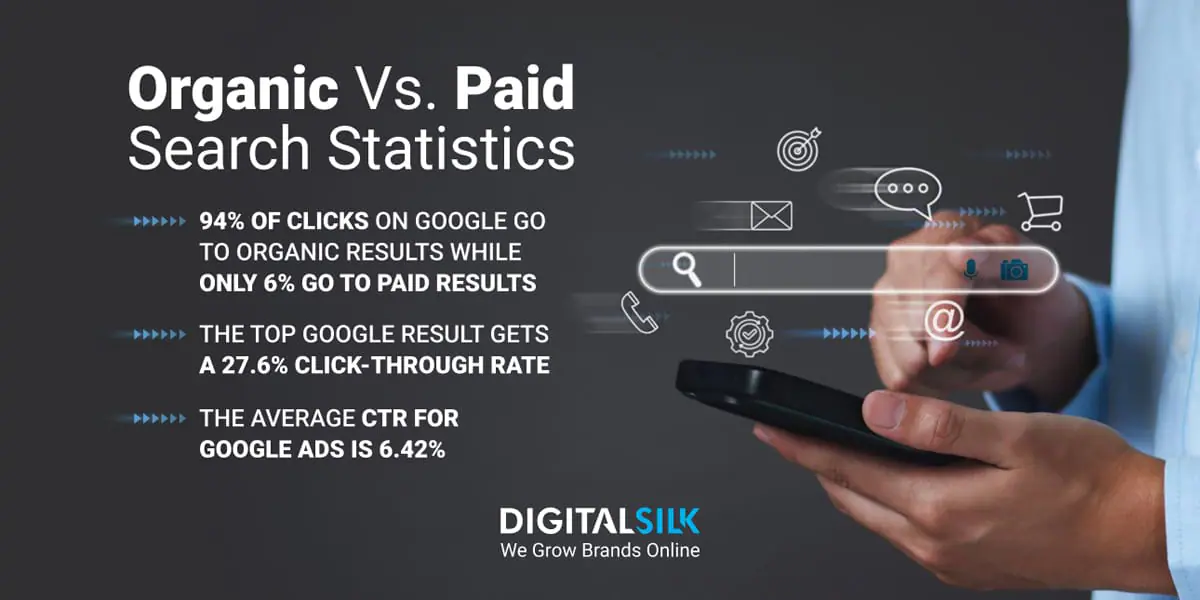
Source: Digital Silk
In the ever-competitive landscape of digital advertising, Google continues to maintain a stronghold in the paid search market, making it a non-negotiable component of any ad strategy. Paired with the exponential rise of mobile usage, businesses must adapt to meet users where they are—on their devices—if they want to stay ahead in the game. As the data shows, mobile-first strategies and Google Ads go hand-in-hand in driving results, and ignoring either can mean leaving valuable clicks and conversions on the table.
- Google claims the lion’s share of the paid search market, with 63% of users preferring to click on Google’s sponsored ads compared to Amazon (15%), YouTube (9%), and Bing (6%). Source
- When consumers are actively shopping online, 64% are more likely to click on a Google ad than on other platforms. Source
- A staggering 97% of Google’s revenue is attributed to pay-per-click (PPC) advertising, underscoring its effectiveness as a business model. Source
- Mobile dominates the paid search landscape, with 70% of search ad impressions in the U.S. occurring on mobile devices. Source
- Google leads mobile paid search, commanding an impressive 95% of paid search clicks on mobile. Source
- Over half of all PPC clicks (53%) come from mobile devices. Source
- Mobile users engage regularly with PPC ads, with 60% clicking on these ads at least once per week. Source
Key Takeaway
The stats tell a clear story: Google is the undisputed champion of paid search, and mobile is the primary battleground. Businesses looking to succeed in the digital advertising space must align their campaigns with the habits of today’s consumers—those who are constantly connected via mobile and searching primarily on Google. Incorporating a mobile-first approach doesn’t just mean designing ads and landing pages optimized for small screens; it also involves understanding how mobile users interact with content, leveraging features like click-to-call ads, and prioritizing speed to reduce friction in the buyer’s journey.
Pro Tip:
Are Google Ads worth it? Maximize the impact of your mobile advertising by using responsive campaigns and dynamic search ads in Google Ads. These tools help tailor creative assets to different user intents while ensuring a seamless experience across devices. And remember, split your budget intelligently—investing in Google’s PPC power while experimenting with other platforms like social and shopping could unearth new opportunities to expand your reach.
Video Content for Maximum Paid Social Impact
In an era dominated by short attention spans, video content has proven to be the linchpin for driving meaningful engagement in paid social media campaigns. Its ability to communicate complex messages quickly, visually, and emotionally resonates with audiences in ways that static content simply can’t achieve. Beyond engagement, video also delivers remarkable cost-efficiencies, making it a must-have in any social media advertiser’s toolkit.
- For Facebook ads, the average click-through rate (CTR) across all industries is 0.90%. Source
Key Takeaway
These numbers tell a clear story: video doesn’t just grab attention—it converts it into action. From slashing costs to fueling audience interaction, video content amplifies paid social media efforts by delivering measurable results. To take full advantage, explore a diverse range of video types, like short-form clips for quick engagement or storytelling ads that build an emotional connection.
Pro Tip:
Always tailor your video content to fit the platform it’s on. For instance, vertical video performs better on Instagram Stories, while longer, narrative-driven formats thrive on Facebook or YouTube. Don’t forget to analyze performance data regularly to refine and optimize future campaigns.
Engagement Trends Across Paid Media Platforms
Understanding how users interact with paid media on various platforms is the difference between a campaign that captures attention and one that gets overlooked. Each platform cultivates a unique user experience, influencing how audiences perceive and engage with advertisements. By aligning your ad strategy with these platform-specific preferences, you can achieve a more meaningful connection with your target audience and ultimately drive stronger results.
- 38% of TikTok users are open to advertisements, a dramatic contrast to the 4% of general internet users who feel the same way. Source
- 94.36% of YouTube users prefer video ads, while 50% of Amazon users favor product listing and shopping ads, and 55% of Google users prefer text ads. Source
Key Takeaway
This data highlights the critical importance of tailoring ad formats to the nuances of each platform. TikTok users, for example, are significantly more receptive to ads than the average internet user, making the platform fertile ground for creative, engaging content that aligns with its dynamic ecosystem. Meanwhile, video ads dominate on YouTube, pointing to a clear preference for visually immersive experiences in this space. On Amazon, ads that integrate seamlessly into the shopping experience resonate best, while text ads remain a staple on Google, where clarity and directness win the day.
Pro Tip:
Don’t just rely on generic assumptions—test your hypotheses. Use A/B testing to evaluate how different ad formats perform within a specific platform. For instance, experiment with short-form videos on TikTok or carousel shopping ads on Amazon. This iterative approach helps you refine your strategy, ensuring that your campaigns hit the right notes with the right audience.
How Smart Marketers Are Allocating and Optimizing Paid Media Budgets
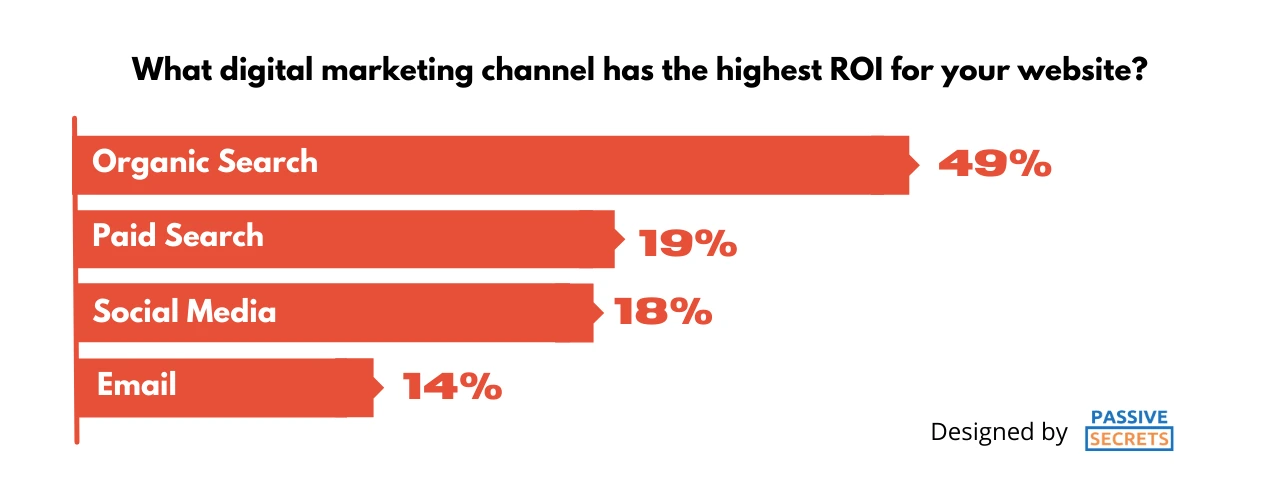
Source: Passive Secrets
As competition for online visibility grows, marketers are placing bigger bets on paid media to capture attention and drive results. However, investing in paid channels like PPC and social media ads is only as effective as the strategy behind it. Without regular performance reviews and optimization, even the most promising campaigns can drain budgets instead of delivering value. Let’s dive into the latest statistics shaping how businesses are allocating and managing their paid media budgets:
- 62% of marketing teams increased their PPC budgets in the past year. Source
- 12% of advertisers’ budgets are allocated to paid social media. Source
- Alarmingly, 72% of companies haven’t reviewed their ad campaigns in over a month, putting them at risk of wasting budget on underperforming ads. Source
Key Takeaway
The growing investment in PPC and paid social underscores their importance in the modern marketing toolkit, but an increased budget does not guarantee results. The real ROI lies in continuous monitoring and optimization. If your campaigns are running on autopilot for months without performance checks, you’re not just leaving money on the table—you’re potentially fueling ineffective ads that no longer align with your audience’s needs or behaviors.
Pro Tip:
Build a habit of conducting in-depth monthly audits for all paid media efforts. During these reviews, focus on identifying trends in click-through rates, cost-per-acquisition, and audience engagement. Make use of tools like Google Ads Performance Planner, Facebook Ads Manager, or third-party analytics platforms to uncover actionable insights faster. By reallocating budget to campaigns that show clear potential, you can maximize both efficiency and ROI.
The Balance Between Paid Media and Organic: Insights on Traffic and B2B Value
Strategizing your digital marketing budget often feels like walking a tightrope between instant visibility and long-term sustainability. Paid and organic efforts each have unique strengths, and their impact depends heavily on your goals, audience behavior, and industry dynamics. For businesses navigating competitive markets, especially in the B2B space, understanding how these approaches perform in generating traffic, sales, and engagement can help you craft a data-driven strategy that delivers results. Let’s dive into some key stats that frame this ongoing debate.
- PPC generates twice the traffic compared to SEO. Source
- Approximately 39% of all eCommerce traffic comes from search, with 35% being organic and only 4% from paid search ads. Source
- 65% of clicks that started with buying keywords go to Google AdWords results, while only 35% go to organic results. Source
- A Databox survey reveals that 30% of respondents find PPC more effective for generating sales than SEO, while 70% believe SEO outperforms PPC. Source
- In the B2B landscape, 84% of marketers consider LinkedIn as the most valuable social media platform for their marketing efforts. Source
Key Takeaway
When it comes to digital marketing, this is not a one-size-fits-all game. The numbers reveal a clear divide: paid media can be a powerhouse for quick wins, particularly for critical buying keywords that drive conversions, while organic search excels as a foundation for sustained growth and trust-building. B2B marketers, in particular, stand to gain by leaning into platforms like LinkedIn, where organic engagement often delivers unparalleled value. The key here? Combining the strengths of both strategies to maximize ROI across both the short and long term.
Pro Tip:
Treat paid media as your sprint and organic strategies as your marathon. Use paid campaigns to jumpstart visibility for new products or services while nurturing trust and authority through long-term organic efforts. To get the most out of your resources, regularly analyze both streams and optimize based on performance data.
Where the Marketing Dollars Go: Investing in Content Marketing and SEO
As the digital landscape grows more competitive, B2B organizations are doubling down on effective, long-term strategies like content marketing and SEO. These organic approaches not only build trust and visibility but also provide a steadier return on investment over time compared to short-term paid campaigns. The allocation of marketing budgets toward these strategies often reflects the organization’s growth stage, with more mature companies investing a greater share of their resources in creating impactful, audience-centered content and optimizing for search.
- B2B organizations allocate an average of 26% of their total marketing budget to content marketing. Source
- The most successful B2B organizations spend approximately 40% of their total marketing budget (excluding staff costs) on content marketing, while the least successful allocate only 14%. Source
- Organizations with sophisticated content marketing strategies invest about 33% of their total marketing budget in content. Source
- Organizations in the adolescent and young/first steps phases of content marketing spend 25% and 19% of their marketing budgets on content, respectively. Source
- B2B organizations allocate approximately 15% of their marketing budget to SEO, surpassing investments in AI chatbots (12%) and video marketing (9%). Source
Key Takeaway
The correlation between budget allocation and success underscores the importance of long-term investment in organic strategies. Mature, successful organizations prioritize content marketing and SEO because these tactics consistently yield compounding benefits, such as higher search rankings, stronger brand authority, and better audience engagement. For companies in earlier stages of their organic marketing journey, directing more resources toward developing a thoughtful strategy can pave the way for scalable growth.
Pro Tip:
Regularly audit your content marketing and SEO efforts to ensure alignment with industry trends and your audience’s evolving needs. Pair your investments with analytics tools to measure ROI and identify areas where additional resources could create the most impact
Content Marketing: Trends, Revenue, and What’s Next
Content marketing has evolved into a critical pillar for driving measurable business growth in an increasingly crowded digital space. It’s no longer just about creating awareness—it’s about fueling tangible outcomes like revenue generation and customer retention. From short-form videos to impactful storytelling, businesses that leverage high-performing content formats are positioning themselves to thrive in a competitive market. Here’s what the latest data reveals:
- Content marketing is projected to generate $107 billion in revenue by 2026, a significant increase from $82.3 billion in 2024. Source
- 58% of B2B marketers have reported increased revenue and sales in the past year as a direct result of their content marketing efforts. Source
- The majority (90%) of marketers using short-form video intend to maintain or increase their investment in this format in 2023, recognizing its high ROI and effectiveness. Source
Key Takeaway
These statistics underscore the undeniable financial impact of strategic content marketing efforts. Investing in formats like short-form video has not only proven effective but also serves as a reminder that consumer preferences are shifting toward faster, more engaging ways to consume information.
Pro Tip:
Don’t just produce content—optimize its distribution and longevity. Consider repurposing popular blog posts into short-form videos, infographics, or slide decks to reach multiple audience segments while maximizing ROI. Additionally, use analytics tools to identify top-performing content types and double down on formats that consistently deliver results.
For businesses, particularly in the B2B space, integrating a solid content strategy into a broader B2B website strategy can further amplify these results. Ensuring your website is aligned with your content efforts will not only enhance user experience but also drive conversions and long-term growth.
Dominating Traffic and ROI with Organic Search
Organic search has proven itself as a powerhouse for driving sustainable growth and revenue, consistently outpacing many other marketing channels in effectiveness. Unlike paid media, which often delivers short-lived results, SEO compounds over time, creating an enduring source of high-quality traffic. For industries where competition for visibility is fierce, investing in organic search isn’t just a strategy—it’s a competitive necessity.
- B2B companies generate twice as much revenue through organic search compared to other marketing methods by capturing leads and prospects directly from their websites. Source
- SEO delivers over 1,000% more traffic compared to organic social media efforts. Source
- The Pharmaceutical sector secures an SEO ROI of 826%, underscoring the potential in regulated industries. Source
- Manufacturing sees a strong SEO ROI of 813%, showcasing the relevance of SEO in traditional industries. Source
- Solar Energy harnesses SEO with an ROI of 770%, proving its value in the growing renewable energy market. Source
Key Takeaway
The numbers clearly demonstrate how organic search offers exceptional ROI across a variety of industries. Beyond its statistical advantages, SEO excels at capturing demand and nurturing intent-driven visitors ready to convert. Sectors like B2B and energy are leveraging SEO to not only generate traffic but also establish authority and trust at key customer touchpoints. Businesses that fail to prioritize SEO risk falling behind competitors who are building long-term momentum through this channel.
Pro Tip:
To reap the full benefits of your SEO efforts, focus on high-intent keyword targeting, optimize your content for user experience, and stay on top of algorithm updates. Tools like SEMrush, Ahrefs, and Google Search Console can help you fine-tune your strategy and uncover new opportunities for growth.
Finding the Right Balance: Advertising, Content, and Email in B2B Marketing
B2B marketing is all about precision and impact, and the way budgets are allocated reflects this strategic intent. Advertising and content dominate the spend, as businesses aim to expand their reach and establish thought leadership. Yet, email marketing remains a cornerstone for nurturing leads and sustaining long-term client relationships, providing a lower-cost yet high-ROI option for targeted engagement. Striking the right balance across these channels is key to building an agile and effective marketing mix.
- B2B marketers allocate the highest share of their budgets to advertising (19%) and content (17%), with both areas expected to remain top priorities. Source
- Email marketing accounts for an average of 7.8% of total marketing spend in B2B organizations, solidifying its role as a cost-effective channel. Source
Key Takeaway
The takeaway here isn’t just about dividing your budget—it’s about creating synergy. While advertising and content help attract initial interest, email marketing excels at nurturing leads and driving conversions. To maximize your efforts, focus on integrating these channels for a seamless customer journey. For instance, use advertising and content to pull in new prospects, and follow up with personalized email campaigns to guide them further down the funnel.
Pro Tip:
Leverage tools like marketing automation platforms to streamline workflows between advertising, content, and email efforts. This allows you to deliver consistent messaging at the right time without overwhelming your audience. Additionally, monitor trends in audience behavior—such as shifts toward shorter content formats or new ad networks—and adjust your spending accordingly to stay ahead in a competitive market.
Conclusion
The debate between paid media and organic strategies is not about choosing one over the other—it’s about understanding how they complement each other. Paid media’s ability to deliver immediate visibility, precise targeting, and faster results makes it indispensable for businesses seeking quick wins or entering competitive markets. On the other hand, organic channels like SEO and content marketing offer sustainable growth and unmatched ROI with their compounding benefits over time. Together, they form a balanced marketing strategy that drives both short-term gains and long-term success.
For marketers, the key lies in strategic budget allocation. By combining the instant impact of paid campaigns with the longevity of organic efforts, businesses can optimize their reach, engagement, and conversions. Whether it’s leveraging PPC for targeted traffic, harnessing the power of video in social media ads, or refining SEO strategies for stronger organic presence, the synergy of these channels is where real growth happens.
Ready to boost your traffic and grow your website? Your customers are looking for you, and our SEO services can help you be found across search engines. Let us help you craft a marketing mix that delivers results today while paving the way for tomorrow.
Paid Media vs. Organic: Where the Budget Goes and Why
This guide was written by the Scopic Studios team and reviewed by Araksya Hakobjanyan, SEO Lead at Scopic Studios.
Scopic Studios delivers exceptional and engaging content rooted in our expertise across marketing and creative services. Our team of talented writers and digital experts excel in transforming intricate concepts into captivating narratives tailored for diverse industries. We’re passionate about crafting content that not only resonates but also drives value across all digital platforms.
Note: This blog’s feature image is sourced from Freepik.







